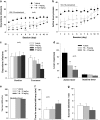Dopamine D3R antagonist VK4-116 attenuates oxycodone self-administration and reinstatement without compromising its antinociceptive effects
- PMID: 30555159
- PMCID: PMC6785005
- DOI: 10.1038/s41386-018-0284-5
Dopamine D3R antagonist VK4-116 attenuates oxycodone self-administration and reinstatement without compromising its antinociceptive effects
Abstract
Prescription opioids such as oxycodone are highly effective analgesics for clinical pain management, but their misuse and abuse have led to the current opioid epidemic in the United States. In order to ameliorate this public health crisis, the development of effective pharmacotherapies for the prevention and treatment of opioid abuse and addiction is essential and urgently required. In this study, we evaluated-in laboratory rats-the potential utility of VK4-116, a novel and highly selective dopamine D3 receptor (D3R) antagonist, for the prevention and treatment of prescription opioid use disorders. Pretreatment with VK4-116 (5-25 mg/kg, i.p.) dose-dependently inhibited the acquisition and maintenance of oxycodone self-administration. VK4-116 also lowered the break-point (BP) for oxycodone self-administration under a progressive-ratio schedule of reinforcement, shifted the oxycodone dose-response curve downward, and inhibited oxycodone extinction responding and reinstatement of oxycodone-seeking behavior. In addition, VK4-116 pretreatment dose-dependently enhanced the antinociceptive effects of oxycodone and reduced naloxone-precipitated conditioned place aversion in rats chronically treated with oxycodone. In contrast, VK4-116 had little effect on oral sucrose self-administration. Taken together, these findings indicate a central role for D3Rs in opioid reward and support further development of VK4-116 as an effective agent for mitigating the development of opioid addiction, reducing the severity of withdrawal and preventing relapse.
Figures






References
Publication types
MeSH terms
Substances
Grants and funding
LinkOut - more resources
Full Text Sources
Other Literature Sources

